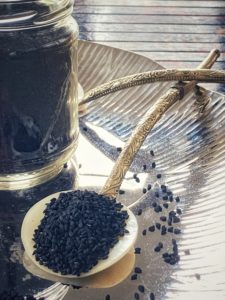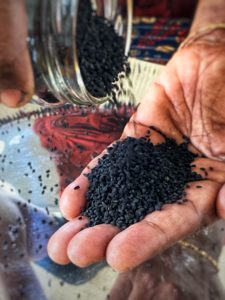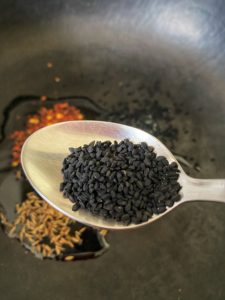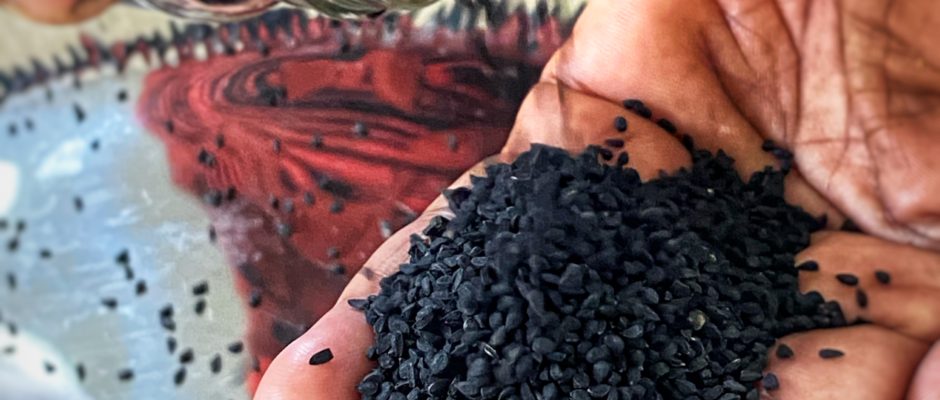Simplicity Coimbatore, Kalonji is different from black cumin ? </a
Wikkipedia Black cumin vs Nigella seeds </a

It’s funny how sometimes you go searching for one thing and it takes you elsewhere and almost makes us forget what we were looking for in the first place.
That’s how this kalonji post came about ! I was looking for different recipes for baingan barta (mashed brinjal dish) using small brinjals because that’s the only kind we were growing at the farm. People think it shouldn’t matter as long as it is brinjal but there are distinct taste differences between the large eggplant / aubergine and our small native kathirikkai.
A barta is a dish infused with smoky flavours similar to that of a sutta kathirikkai gothsu. I was looking at several recipes to look at the different spices in play for this dish. The recipes had one thing in common .A baingan barta is incomplete without the addition of kalonji. Interestingly we still do not know the Tamil name for this seed which is exactly one reason why I have been inspired to write this post.
A while ago on my food groups, friends were asking what kalonji was called in Tamil. A lot of people insist it is karunjeeragam (karuppu seeragam) but it isn’t. Black cumin is an ingredient which looks exactly like the cumin in texture and shape but is of a darker colour and slightly longer. It’s referred to in hindi as ‘kala jeera’ and is not the same as ‘kalonji’. The only similarity are the first two alphabets in both names !
So when I went looking for this ingredient, the shops here in Coimbatore actually sell it under the label ‘black cumin’.
The actual name in English is Nigella seeds. Most of us are popular with the cookery show host Nigella Lawson and her flair for talking about food. It was when watching one of her shows that I first heard of the nigella seeds. She was in fact putting together an Indian meal which consisted of Naan,Mughlai chicked, matar paneer and basmati rice with nigella seeds. She even remarked that it looked like black tears…she can be rather poetic and dramatic on more than one occasion.
She is right however about the description.The seeds are as black as the night ,flat and shaped like teardrops .I must confess that I rarely find use for them in my cooking. It’s not an ingredient which plays a part in the kind of South Indian food which we grew up eating.
I have often spotted it used on the surface of flat breads like a butter naan or roti but the exact taste of this particular ingredient was rather unfamiliar to my palate.
That’s why making this barta had to be precise. The kalonji or nigella seed is supposed to add a husky note to the dish. The charring of the brinjal skin is what gives the burnt charcoal feel to the dish. When the kalonji is fried in the oil before adding the brinjal, it releases a definitive taste which complements the roasted brinjal pulp.
The botanical name is Nigella sativa and it is apparently a flowering plant which is native to India. Images show large white flowers with bulbous centres from which sprout these follicles with clusters of seeds.
The taste is described as pungent and peppery…what I tasted was more of a oniony bite.All of us who have eaten store bought pizza are familiar with the small bottles or sachets of dried oregano. If you rub the kalonji seeds between the fingers, the aroma is so similar to that of the oregano.
We made the barta a little more chunky and didn’t mash it completely…could not hold the tiny brinjals too long on the flame because of the heat.The larger brinjals are far easier to manoeuvre. So the barta does have small chunks of the edges of brinjal which weren’t charred. It still tasted great though.

These jet black seeds are also commonly used in pickles is what I am told by friends. The health benefits are quite impressive and quite unexpected. Kalonji oil seems to be a widely used kitchen remedy from curing headaches , tooth aches and providing pain relief from inflamed joints.
Drinking a few kalonji seeds in warm water is said to boost metabolism as well as immunity. There are also specific kalonji remedies to more serious health issues ,do look it up.
Because of the diminutive size, a pack of 100 gms goes a long way. The tip to buying good quality and fresh kalonji lies in the colour. It’s best to not buy the ones which look pale or grey .The seeds are best stored in a dry area to prevent them from going rancid.
The black cumin seeds (shah jeera) on the other hand are also called caraway seeds in the UK. Ever heard of caraway seed cake? …it’s in all the Enid Blyton picnic stories.”
The kalonji also adds a crunch when cooked. It reminds me of the sesame seed in that respect.

There are so many interesting recipes featuring this nigella seed. There’s even a paste made out of the kalonji which is used in desserts in Palestinian cuisine. It’s called Qizha. The process is apparently somewhat similar to that of making a black tahini…that certainly sounds worth trying doesn’t it ?! Since I do have a whole bottle of kalonji sitting in my kitchen now, I should make best use of it.
All that’s remaining is to figure out the tamil name for it ! How can we keep calling it karunjeeragam when there are black cumin seeds which are so different from these (face in palm)
Shah jeera is different from Kalonji !
Caraway seeds vs Nigella
In Tamil ?



No comments yet.